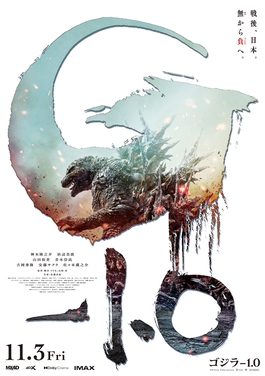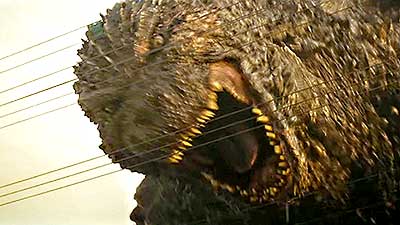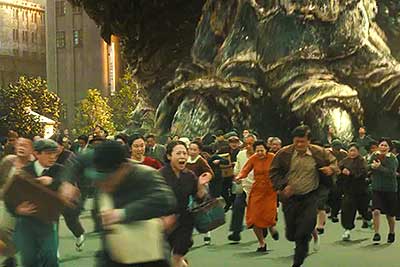 It was inevitable that Japan’s Toho Studios, after decades of aggressively rebranding Godzilla for the international market (with GODZILLA 1985, GODZILLA 2000 and SHIN GODZILLA), would eventually get it right. It took until 2023, with Toho’s 33rd GODZILLA movie, for that to occur—GODZILLA MINUS ONE (Gojira -1.0), released in subtitled form, unexpectedly dominated the US box office (together with Studio Ghibli’s THE BOY AND THE HERON/Kimitachi wa dô ikiru ka, another unexpectedly lucrative Japanese language release).
It was inevitable that Japan’s Toho Studios, after decades of aggressively rebranding Godzilla for the international market (with GODZILLA 1985, GODZILLA 2000 and SHIN GODZILLA), would eventually get it right. It took until 2023, with Toho’s 33rd GODZILLA movie, for that to occur—GODZILLA MINUS ONE (Gojira -1.0), released in subtitled form, unexpectedly dominated the US box office (together with Studio Ghibli’s THE BOY AND THE HERON/Kimitachi wa dô ikiru ka, another unexpectedly lucrative Japanese language release).
It’s no secret that Godzilla functions as a stand-in for the 1945 nuclear holocaust unleashed on Japan by the US, a metaphor that if leaned into overmuch can result in a serious downer (as was the case with GODZILLA 1985). That aspect is certainly acknowledged in GODZILLA MINUS ONE, but the main focus is on the Japanese military’s failures, and the need for Japan’s citizens to work together to make things right.
The story begins, appropriately, in 1945. Godzilla (if you don’t already know what the critter looks like see the poster illustration) makes his first appearance in an attack on a secluded Japanese military base. The melee is witnessed by Koichi (Ryunosuke Kamiki), a disgraced kamikaze pilot who shirked his military duties, and who further embarrasses himself by being hesitant about using the gun on his fighter plane to shoot Godzilla.
Koichi winds up becoming a minesweeper, which involves detonating ocean-based mines. In so doing he once again runs into Godzilla–who, strengthened by nuclear tests carried out by the United States, attacks warships. Koichi also gets into a relationship with Noriko (Minami Hamabe), a young woman, and an orphaned girl she’s taking care of (kid characters being Godzilla movie mainstays).
Two years later Godzilla inevitably makes his way onto land, and devastates the city where Noriko is employed (leaving behind a devastated landscape that evokes Hiroshima and Nagasaki). She’s killed (it seems) in the melee, which motivates Koichi to redouble his wartime efforts and take on Godzilla. He’s aided by Tachibana (Munetaka Aoki), a mechanic who survived the initial island onslaught. Tachibana distrusts Koichi but agrees to fix up a broken-down fighter plane prototype so Koichi, in defiance of plans made by the military, can fly into Godzilla’s mouth and complete his kamikaze mission.
This being a GODZILLA movie, it’s probably wrong to complain about things like perfunctory characterizations (with Noriko’s actions and ultimate fate dictated by narrative demands rather than internal motivation) and a predictable arc (with Koichi outlining exactly what happens in the ending long before it occurs). Subtlety and nuance aren’t things one can reasonably expect, although writer-director Takashi Yamazaki comes about as close as possible to providing them without losing sight of the requisite GODZILLA mayhem.

Takashi Yamazaki is a special effects supervisor turned director. That can be a hinderance (think back to 2010’s beyond-crappy SKYLINE, made by the VFX supervisors turned directors Colin and Greg Strause), but Yamazaki manages to locate that elusive sweet spot where human interest and special effects intersect. If this isn’t the best Godzilla movie ever made (as some, including Hollywood GODZILLA movie director Gareth Edwards, have claimed) it’s certainly up there.
The highly innovative symphonic score by Naoki Satō is instrumental to the overall effect. So too the imagery of cinematographer Kōzō Shibasaki, which in contrast to most GODZLLA movies uses natural light to its advantage. The acting by Ryunosuke Kamiki and Minami Hamabe in the lead roles isn’t even bad, although the true star is the title character, restored here to his rightful place as a figure of terror (as opposed to those misguided GODZILLA movies in which he was made a good guy). The CGI Godzilla depicted here may be a bit divergent from the guy in a suit we’ve become used to, but the critter’s appearance, and accompanying destruction, are superbly pulled off—and done so, if the publicity is to be believed, for under $15 million, a fraction of the cost of the average Hollywood blockbuster.
Vital Statistics
GODZILLA MINUS ONE (Gojira -1.0)
Toho Studios
Director: Takashi Yamazaki
Producers: Minami Ichikawa, Shūji Abe, Kenji Yamada, Kazuaki Kishida, Gō Abe, Keiichirō Moriya
Screenplay: Takashi Yamazaki
Cinematography: Kōzō Shibasaki
Editing: Ryūji Miyajima
Cast: Ryunosuke Kamiki, Minami Hamabe, Yuki Yamada, Munetaka Aoki, Hidetaka Yoshioka, Sakura Ando, Kuranosuke Sasaki, Sae Nagatani, Mio Tanaka, Yuya Endo

